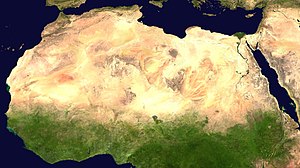5.9 kiloyear event

The 5.9-kiloyear event was one of the most intense aridification events during the Holocene. It occurred around 3900 BC (5900 years Before Present), ending the Neolithic Subpluvial.
It is associated with the last round of the Sahara pump theory, and probably initiated the most recent desiccation of the Sahara, as well as a five century period of colder climate in more northerly latitudes. It triggered human migration to the Nile, which eventually led to the emergence of the first complex, highly organized, state-level societies in the 4th millennium BC.[1] It may have contributed to the decline of Old Europe and the first Indo-European migrations into the Balkans from the Pontic–Caspian steppe.
Cause[edit]
A model by Claussen et al. (1999) suggested rapid desertification, associated with vegetation-atmosphere interactions following a cooling event, Bond event 4.[2] Bond et al. (1997) identified a North Atlantic cooling episode 5,900 years ago from ice-rafted debris as well as other such events, now called Bond events, which indicate the existence of a quasiperiodic cycle of Atlantic cooling events approximately every 1500 years ± 500 years.[3][4] For some reason, all the earlier arid events (including the 8.2-kiloyear event) were followed by recovery, as is attested by the wealth of evidence of humid conditions in the Sahara between 10,000 and 6,000 BP.[5] However, it appears that the 5.9-kiloyear event was followed by a partial recovery at best, with accelerated desiccation in the millennium that followed.
For example, Cremaschi (1998) describes evidence of rapid aridification in Tadrart Acacus of southwestern Libya, in the form of increased aeolian erosion, sand incursions and the collapse of the roofs of rock shelters.[6] The 5.9-kiloyear event was also recorded as a cold event in the Erhai Lake (China) sediments.[7]
Effects[edit]
In the eastern Arabian Peninsula, the 5.9-kiloyear event may have contributed to an increase in relatively greater social complexity and have corresponded to an end of the local Ubaid period[8] and the emergence of the first state societies at the lower end of the Tigris and Euphrates Rivers in southern Mesopotamia.[9]
In central North Africa it triggered human migration to the Nile, which eventually led to the emergence of the second complex, highly organized, state-level societies in the 4th millennium BC.[1]
By causing a period of cooling in Europe, it may have contributed to the decline of Old Europe and the first Indo-European migrations into the Balkans from the Pontic–Caspian steppe. Around 4200–4100 BCE a climate change occurred, manifesting in colder winters in Europe.[10] Between 4200–3900 BCE many tell settlements in the lower Danube Valley were burned and abandoned,[10] while the Cucuteni–Trypillia culture showed an increase in fortifications,[11] meanwhile moving eastwards towards the Dniepr.[12] Steppe herders, archaic Proto-Indo-European speakers, spread into the lower Danube valley about 4200–4000 BCE, either causing or taking advantage of the collapse of Old Europe.[13]
See also[edit]
- Timeline of environmental history
- Bond event
- 4.2-kiloyear event
- 8.2-kiloyear event
References[edit]
- ↑ 1.0 1.1 Brooks, Nick (2006). "Cultural responses to aridity in the Middle Holocene and increased social complexity". Quaternary International. 151 (1): 29–49. Bibcode:2006QuInt.151...29B. doi:10.1016/j.quaint.2006.01.013.
- ↑ Claussen, Martin; et al. (1999). "Simulation of an Abrupt Change in Saharan Vegetation in the Mid-Holocene". Geophysical Research Letters. 26 (14): 2037–40. Bibcode:1999GeoRL..26.2037C. doi:10.1029/1999GL900494.
- ↑ Bond, G.; et al. (1997). "A Pervasive Millennial-Scale Cycle in North Atlantic Holocene and Glacial Climates" (PDF). Science. 278 (5341): 1257–66. Bibcode:1997Sci...278.1257B. doi:10.1126/science.278.5341.1257.
- ↑ Obrochta, Stephen P.; Miyahara, Hiroko; Yokoyama, Yusuke; Crowley, Thomas J. (2012-11-08). "A re-examination of evidence for the North Atlantic "1500-year cycle" at Site 609". Quaternary Science Reviews. 55: 23–33. Bibcode:2012QSRv...55...23O. doi:10.1016/j.quascirev.2012.08.008.
- ↑ Petit-Maire, N.; Beufort, L.; Page, N. (1997). "Holocene climate change and man in the present day Sahara desert". In Nüzhet Dalfes, H.; Kukla, G.; Weiss, H. Third Millennium BC Climate Change and Old World Collapse. Berlin: Springer. pp. 297–308. ISBN 978-3-540-61892-8. Search this book on

- ↑ Cremaschi, M. (1998). "Late Quaternary geological evidence for environmental changes in south-western Fezzan (Libyan Sahara)". In Cremaschi, M.; Di Lernia, S. Wadi Teshuinat: Palaeoenvironment and prehistory in south-western Fezzan (Libyan Sahara). Firenze: Ed. All' Insegna del Giglio. pp. 13–47. ISBN 978-88-7814-144-5. Search this book on

- ↑ Zhou, Jing; Wang, Sumin; Yang, Guishan; Xiao, Haifeng. "Younger Dryas Event and Cold Events in Early-Mid Holocene: Record from the sediment of Erhai Lake" (PDF). Advances in Climate Change Research. 3 (supplement): 41–44. 1673-1719 (2007) Suppl.-0041-04. Archived from the original (pdf) on 10 September 2008. Retrieved 3 June 2014.
- ↑ Parker, Adrian G.; Goudie, Andrew S.; Stokes, Stephen; White, Kevin; Hodson, Martin J.; Manning, Michelle; Kennet, Derek (2006). "A record of Holocene climate change from lake geochemical analyses in southeastern Arabia" (PDF). Quaternary Research. Elsevier. 66 (3): 465–476. Bibcode:2006QuRes..66..465P. doi:10.1016/j.yqres.2006.07.001. Archived from the original (pdf) on 10 September 2008. Retrieved 3 June 2014.
- ↑ Fagan, Brian. 2004. People of the Earth: An Introduction to World Prehistory. Upper Saddle River NJ: Pearson/Prentice Hall. Page 355.
- ↑ 10.0 10.1 Anthony 2007, p. 227.
- ↑ Anthony 2007, p. 230.
- ↑ Anthony 2007, p. 232.
- ↑ Anthony 2007, p. 133.
Further reading[edit]
- Anthony, David W. (2007). The Horse, The Wheel, and Language : How Bronze-Age Riders From the Eurasian Steppes Shaped The Modern World. Princeton University Press. ISBN 978-0-691-14818-2. Search this book on

This article "5.9 kiloyear event" is from Wikipedia. The list of its authors can be seen in its historical and/or the page Edithistory:5.9 kiloyear event. Articles copied from Draft Namespace on Wikipedia could be seen on the Draft Namespace of Wikipedia and not main one.
